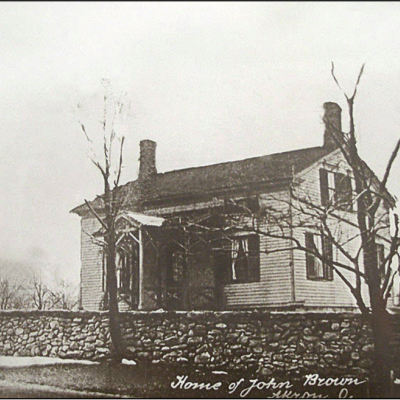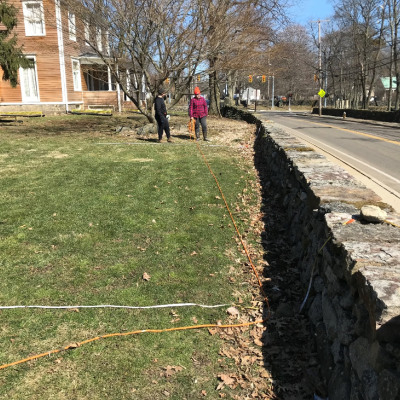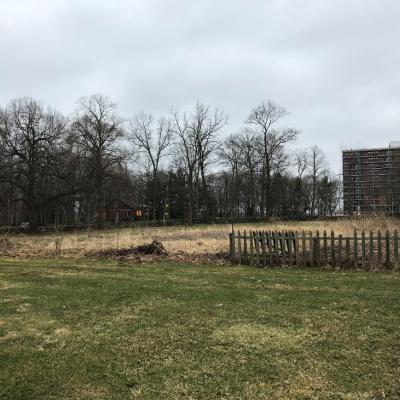The Summit County Historical Society contracted with SHiP to conduct an archaeological survey in preparation for a new parking lot to be constructed near the John Brown House in Akron, Summit County, Ohio. The goal of the archaeological investigation was to identify prehistoric and historic cultural resources within the project area, and to determine the eligibility of identified resources for the National Register of Historic Places. The project area was approximately 0.88 acres in size, consisting mostly of mowed grass lawn, and an approximately quarter acre fenced garden left fallow. It is located adjacent the historic Portage Path, which was used to transport people and goods between the Lake Erie and Ohio River watersheds.
SHiP conducted a reconnaissance survey of the southern portion of the John Brown House property. Non-invasive metal detection (active) and magnetic gradiometry (passive) geophysical survey techniques were used within the project area. Iron bearing “hits” on the metal detector were ground-truthed with a bucket auger. The bucket auger was also used to systematically survey the project area that was not subject to magnetic gradiometry survey. A total of 40 bucket auger pits and seven shovel test units were excavated within the survey area.
Approximately 662 artifacts were recovered during the survey of the John Brown House property. The artifact scatters can be broadly grouped into three general areas: house refuse adjacent the house, dense refuse around Test Unit A (expanded into test unit 1), and general residential refuse.
The house refuse included 27 bone fragments from various small mammals, including potential sheep and pig long, flat, and distal limb bones. There were also two small bird bone fragments, which likely came from a small chicken. At least one of the mammal bone fragments had a butcher/cut mark. Fifteen pieces of window glass were recovered in this area. Using Moir’s regression equation, when all 15 pieces were combined, the estimated date of the glass was 1874 plus or minus 7 years. In addition to these architectural remains, there were also pieces of roofing nails, wire cut nails, Mediterranean style ceramic roof tiles, slate roof tiles, clinker/exhausted coal pieces, vinyl siding fragments, drainage tiles, and whiteware ceramics. Throughout this area, a thick layer of clinker and coal deposits were overlaying disturbed soils. This soil profile, coupled with the wide time range of diagnostic materials from the 19th century to the mid-20th century, indicates a highly disturbed area representative of frequent refuse deposits from within both the “bird house” and the John Brown house.
The slightly denser scatter around test unit 1 is potentially related to an expedient or minimally designed outbuilding/structure. This area also contained the largest amount of window glass, the estimated date of which was 1830 plus or minus 7 years. Five square cut nails were too corroded to identify specific cuts, but can be dated between 1810 and 1900. A hand-painted piece of whiteware found here may also be from the same time period. The only other early 19th century artifacts include two fragments of creamware.
The general residential refuse included 21 pieces of window glass, 9 pieces of whiteware, three pieces of amber bottle glass, four pieces of aqua bottle glass, four pieces of clear bottle glass, a piece of dark green hand blow bottle glass, and other small pieces of glass. Two bone fragments and the hand blow bottle neck were located very close the John Brown House, likely reflecting ephemeral refuse deposits associated with activities within the house. Two pieces of French gunflint, from Le Grand Pressigny Flint quarries of France were found in the eastern most portion of the project area, near the stone wall. French gunflints were common to Ohio historic sites up to the war of 1812. However, the gunflint from one auger test was highly reworked on all edges indicates the gunflint was used extensively. A gunflint found in another test unit had an ovate end that may reflect re-purposing for scraping activities. Native Americans commonly re-worked gunflints for other tools
Prehistoric artifacts located on the site included one retouched flake and two pieces of fire-cracked rock.
The John Brown House site, 33 SU 693, was added to the Ohio Archaeological Inventory as a result of this survey.



